Living body/ies - FUTURE IS NOW: ARTIVISM’S URGENT CALL FOR ACTION! FROM THE MINING STATE OF MINAS GERAIS IN BRAZIL TO THE MOUNTAINS OF WALES
As the planet reaches a red alert for its survival, how can dance, theatre and activism be a potent weapon to transform the destructive ways in which humans relate to nature and other living beings? How can we creatively disrupt reality’s “business as usual” through humour and transgression to create a place of refuge that resists the atrocities imposed by governments and private capital?
In 2011, moved by a strong desire to connect with my roots, I worked with English filmmaker Richard Bleasdale in a series of short films shot in the Brazilian Amazon. I was in love with Brazil again: moved by its natural environment’s beauty and abundance, its people’s flair and warmth. I was also shocked and horrified by the destruction of the Amazon and the lack of respect shown towards indigenous tribes. How could I go back to the UK and not do anything to help my homeland? How could I make a difference with my contemporary practice to benefit the people and the natural environment in Brazil? How could I leave enclosed elitist theatre spaces and perform outdoors to demand accountability from governments and companies that were destroying the environment? With this in mind, I submitted a project that was awarded a grant. Projeto Trans-Amazônia proposed travelling the 4,260 km of the Transamazônica Highway (BR-230) exactly 40 years after its inauguration during the Brazilian dictatorship regime. In an epic journey I travelled for 6 months crossing 30 locations (cities, towns, villages and indigenous settlements), in seven Brazilian states. My intention was that “Trans-Amazônia” would pose the following questions: What is the relationship of contemporary (wo)man with nature and the natural resources of the Brazilian Amazon? How is contemporary Brazil 40 years after the opening of this large-scale infrastructure development? What physical body emerges from engaging with this environment, and how does it react in regions experiencing conflict? These questions led to meeting people and groups with whom I conducted interviews, facilitated workshops for and where I created site-specific performances with the local knowledge I gathered.
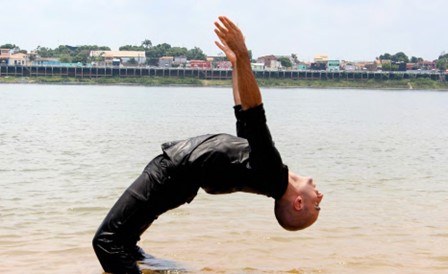
How I became an artivist
In Altamira, Pará, I created a performance entitled Bela Morte = Belo Monte (“Beautiful Death = Belo Monte”), with the support of my partner Maggi Swallow, 100 local indigenous fishermen and the Xingu Vivo Para Sempre Movement. This took place outside the offices of Norte Energia – the consortium building the controversial 11,200-megawatt Belo Monte Hydroelectric Dam – who had invited fisherman and indigenous groups to the meeting and then prevented them from entering. It would change my life forever.
Bela Morte included the following elements and actions:
- durational performance through the city dragging a heavy wooden canoe;
- blocking the street and part of the stairs leading up to the front doors with hazard- tape;
- instant composition using movement, text and objects - following a script of ac- tions and interacting with the space and the audience;
- use of plants and plastic sheets;
- face painting using elements of clown make-up combined with indigenous facial designs;
- use of balloons filled with "blood" (water, red and blue food colouring);
- performative "deaths" on the street;
- direct contact and a successful attempt to enter the offices with local fishermen and indigenous people to disrupt the meeting.
By combining clowning and buffoonery, I am critical and ironic about the negative impact of the Hydroelectric Dams impact on the region. Charming and scary; fragile and powerful. I confront the public, expose data, human failures and myself. My clown does no harm to anyone. I create direct but non-violent actions, where the action always happens to me - the fake blood bombs that explode, the fish that beats, the mud that stains, the falls and false deaths.
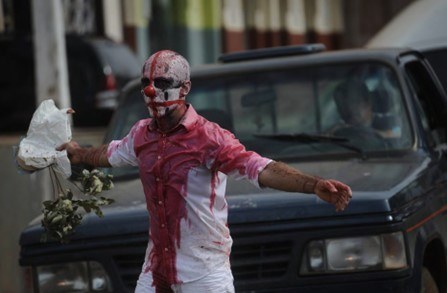
How becoming an artivist impacted and impacts my work
There was no going back after I became an artivist. It was as if a switch had been turned on and it impacted all my work: artistic, production, finances, relationship with producers and venues, touring. Since making Trans-Amazônia my artistic focus has rested on environmental issues - mainly related to Brazil, but also to the whole planet.
From a funding point of view, it made me conscious of who would support my work and whether I would accept that funding or not. In Brazil and in the UK there are many companies supporting the arts that are clearly damaging the environment. How can I accept support from companies whose change of behaviour and accountability I'm protesting for? How can a contemporary art form that is primarily an art of protest and contests the establishment, greenwash the money that kills our forests and rivers? In October 2019, I was arrested while performing in one of Extinction Rebellion’s major protests in London. I was then charged and received a caution. This situation caused extreme stress to me and my close family, having financial and professional consequences, and I now have a caution on my DBS (Disclosure Barring Service). In 2021, The Police, Crime, Sentencing and Courts Bill new bill stated that those who cause annoyance could be jailed up to 10 years. How can we pursue artivism in a society that increasingly suppresses social movements? In Brazil in 2022, British journalist Dom Phillips and Indigenous expert Bruno Pereira were shot while journeying through the Amazon. Brazil holds the record for the number of environmentalists who have been murdered. How can we carry out artivist practices considering such dangerous situations? Due to lockdown and the fear of being arrested again, I pursued performances that were not direct actions in the street, but had some form of shielding either online, video pieces or as part of outdoor theatre festivals. I still consider my direct action pieces one of my biggest strengths and look for ways in which I can further progress that aspect within the current context.
How it impacts my creativity
Being an artivist makes me feel alive, brings me closer to my community and to the values that I care about. It pushes me to take risks creatively and also makes those risks count directly towards the environmental causes. Many of my performances are solo pieces, but it’s also extremely important to work with the communities affected by the eco-crimes and also work with other protesters.
Nosso Luto, Nossa Luta - a performance on the top of a mountain with an audience of a 1000 people
The crime-tragedy of Brumadinho in Brazil occurred on 25 January 2019 when a tailings dam (an earth-fill embankment dam used to store by-products of mining operations) suffered a catastrophic failure killing 270 people. The dam is owned by Vale S.A., the same company responsible for the 2015 Mariana dam crime-tragedy. This incident had a huge impact on me, as it occurred in my home state and not far from Belo Horizonte. I was extremely upset and saddened by this event. Not long after I was invited by the NGO Abrace a Serra da Moeda to create a performance-protest on the 21st of April 2019 at the top of the Moeda mountain for Embrace the Serra da Moeda. This was a protest organised by the NGO who fight to protect the waters and mountains of Minas Gerais. Nosso Luto Nossa Luta was my performance inside this event. Unlike previous years, where the participants wore white clothes, on Easter Sunday the colour chosen was black, as a way of reinforcing mourning. I felt it was urgent to create something powerful and important that could create visibility for the affected communities, create a vehicle for their dissatisfaction and create opportunities for demanding justice and integrity from the company Vale S.A. I directed the performance working with approximately 30 performers. At the end of the presentation, all participants and the audience were invited to interact in the performance, forming the phrase ‘our mourning, our struggle’, the theme of the event that year and this was photographed from above by drone. The performance text was written by playwright Letícia Andrade.
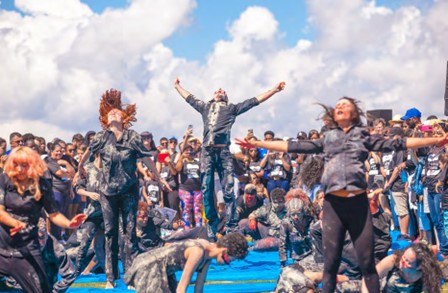
Creative processes
The creative processes address the needs of what the work wants to achieve: generate awareness about the eco-crime with audiences, support the involved communities in meeting their needs with the companies involved, generate visual material for the press and social media platforms. Initially, I read and study the issues in question and then, if possible, visit the sites that have been affected. Other initial research involves: diary, photos and videos, stream of consciousness writing. I then move into a second phase, in a dance/theatre space and also outdoors. I find it productive to work with a combination of spaces: indoor studio spaces and outdoor locations. Each piece has different needs. The performance-protest work in the streets is more immediate and here I work with a set of scores and improvisation. Other pieces such as the solo stage piece for "Trans-Amazônia", took much longer - 6 months of rehearsals. Nosso Luto Nossa Luta was a collaboration with dra- maturg Letícia Andrade and a group of 30 performers. I also created photo performances and video performances in site specific locations. In BentO, I worked with photographer Lucas Brito on the site where the eco-crime in Mariana took place.
Vale Kills – an example of a direct action performance protest piece
On 5th November 2015, the toxic holding dam for Samarco (BHP Billiton / Vale S.A.) at Mariana ruptured causing one of the biggest environmental crimes in Brazilian history. The toxic waste reached the sea 400 kilometres away. In response to that incident I created Vale Kills, which was performed outside the Mayfair hotel in London where mining company Vale was holding its year-end conference to celebrate its achievements with shareholders. An organised group of protesters worked with me on this performance. I had a set score of actions that I’d adapt to the group’s actions and the environment. The group worked as a form of Greek theatre chorus relating to me with call and response chants and movements, and vice versa. On that occasion, we had also to interact with the security guards, hotel manager, staff and at the very end of the action, the MET Office Police. The hotel staff opposed our entrance to the event so our action took place outside. We blocked the road, chanted, used a megaphone to speak about the eco-crime and splashed mud on the entrance (at the end of the action we cleaned everything up as a sym- bolic gesture as to what we felt the companies responsible for the crime should do). As the group spoke, I’d interact with passers-by in the street, the traffic, engage with the security guards (try to "kiss" them after a strip-tease where I undressed to reveal a mini skirt and top with "Brasil" on it. A cheap asset for sale. I created various "false deaths" in the street. I’d whip myself with dead fish as a metaphor to all the fish that died from the toxic waste that was poured on The River Doce and its tributaries. As I perform, I am in a “clown state” (a state of curiosity, playful with – and open to – the environment, stretching this towards transgressive actions) – responding to people’s reactions and what I see / feel / experience (my psycho-physical state and embodiment). I ask the audience questions, I deliver text and movement sequences, I engage with the elements of that specific site (lying on the road, leaning on doors, sitting on the curb). The work combines elements of street theatre, contemporary dance, physical theatre and performance art. There is no “fourth wall” and the audience is part of the performance as much as a witness and as a spectactor (as Augusto Boal would say).
Wales
In 2021, my partner Maggi Swallow and I moved to the beautiful countryside in Wales. We were delighted to be awarded an outdoor commission by Articulture and the Wales Outdoor Arts Consortium. We created Afanc, an outdoor family friendly physical theatre piece that used the well-known Welsh myth of Afanc to draw on issues related to environmental eco-crisis, the amount of plastic and pollution in our rivers and seas and the catastrophic decline of wildlife and our natural world. The piece toured to outdoor venues in Wales and was well received by the audiences who found it both entertaining and thought-provoking. The piece was an artistic welcome to the Welsh arts scene and was also a way to be in action as artivists through a safer way than the performance protests. During lockdown, we delivered an Arts Council of Wales funded online project for performing arts freelancers, “Cylch Sir / Shire Circle”. Mee- ting and listening to freelancers who shared concerns and ideas was a huge privilege. The project gave us the chance to meet key organisations such as Articulture, Theatrau Sir Gar, National Dance Company Wales, National Theatre Wales, Fusion Car- marthenshire, Arts Care, Ground-work Collective, Cultural Freelancers Wales, Wales Dance network, WAHWN, Organised Kaos and gave us a strong initial understanding of the Welsh Arts Sector. In April 2022, I created short videos shot outdoors in one of the forests next to my home. Those video per- formances were devised to support the fight in Brazil for the protection of the underground waters from the pollution of mining companies. This was organised by the NGO Abrace a Serra da Moeda, the same NGO that invited me to direct the performance in 2019. However, in 2022 that protest was not able to take place in person due to Covid restrictions. I created the following video performances: 1. a durational piece where I used a long piece of black cloth to hit the water; 2. a piece where I interact with various elements in the space: large tree trunks, forest paths and at the end, very cold water. The pieces served as a digital protest on social media, whatsapp transmission lists and press in Brazil.
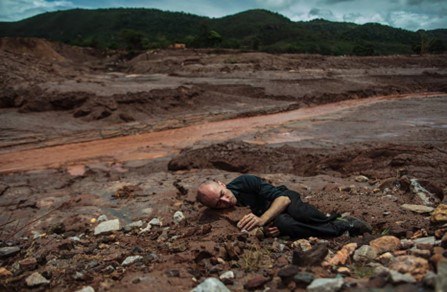
The performing arts industry and the environmental crisis
I find it puzzling how the performing arts industry tackles the environmental crisis and climate change for the following reasons:
- Creating amazing theatre / dance work that deals with the environmental crisis to be featured in outdoor festivals and local venues is excellent, but we need more! The power of artivism lies in its capacity to engage directly with the issues – in protests, in conversations with the companies involved. How can art move away from being just entertainment but make a real shift on those urgent issues?
- On various occasions, I have attempted to engage with fellow colleagues in the industry to create pieces for the street, but felt a great deal of resistance and fear. I know it’s not for everyone, but we need to climb out from behind the safety of our art and let that same art be our activism to address the issues and create change. It’s time to make work that goes beyond small theatre bubbles to reach all sectors of society.
- How can artists accept funding and sponsorship from companies that are clearly damaging the environment? In Brazil, for example, mining company Vale S.A., responsible for major eco-crimes in history, supports various cultural projects in Brazil. How can artivism create pieces to challenge the very same company that is giving them sponsorship? How far can this greenwashing go? Like many other companies, Vale S.A.’s marketing campaigns increasingly portray them as the beacon for new sustainable ways to protect the environment and “give back to the community” that they are regularly damaging.
Materials and pole dancing
Since travelling to the Amazon and seeing the amount of plastic in the rivers and forests, along with the ad-hoc nature of the houses and living arrangements, I started a practice of working with recyclable materials in very improvised ways, making costumes and props for my performances. They are usually tied up with rope, string or tape and their fragility is clearly visible. The audience can spot how it’s made. I transform a watering can into a hat, yellow tubes into a garment that oppresses the body, always with humour and the unexpected. I was also impressed by the vertical aspect of the forest and the large number of electricity poles on the Transamazon highway. I came across pole dancing during my visit to a friend’s studio in Manaus and thought that it would be a unique element to use due to the use of vertical height, flow, acrobatic elements and the ability to de-territorialize pole dance and embed other meanings in its form. I trained in the technique and used it in the stage version of Trans-Amazônia and on street poles in various outdoor performances. It became part of my artivist tool box.
Commitment to activism as a tool for my work
Just like an ant who has an open antenna and is curious, I’m continuously searching for the environmental issues that surround me and connecting with local groups. Creatively that has led me to work collaboratively where I am often invited to establish a leadership role. In 2019, I led the Extinction Rebellion group in Ramsgate and Margate, in Kent, UK. The work consisted of weekly sessions, working with non-professional performers, creating performances for street protests.
Call for action!
In the face of deepening worldwide socio-environmental concerns and crisis, and a seeming alienation of humans from the realities of their basic survival needs: the Earth. To change this scenario, we can make a difference by raising awareness about the climate crisis. I see my work as an artivist as opening the conversation between current and future artivists/activists and communities. It’s essential to continue to pursue new artivist strategies for meaningful performances that embody our relationship to the real rather than the virtual world, towards challenging companies to accept accountability for their damaging actions to the environment.
References
- Aljazeera, (2019), https://www.aljazeera.com/news/2019/10/7/extinction-rebellion-climate-protest-brings-london-to- standstill. Accessed on 18 July 2022.
- Brito, Lucas (2016), ‘Bent-O: uma sirene por responsabilidade’, Flickr, https://www.flickr.com/photos/pipepie/ albums/72157663844933152. Accessed 18 July 2022.
- Extinction Rebellion (2021), ‘About us’, https://extinctionrebellion.uk/the-truth/about-us. Accessed 18 July 2022.
- Rebellion, Extinction Rebellion (2022), Neflix Documentary, Accessed 10 July 2022.
- Faria Rocha, Carlana (2020), Artivisms and Decolonial Attitude Emergencies: Protest Actions? The Action ‘Nosso luto, nossa luta’ (‘Our Grief Our Struggle’) by the Memories of an Artivist, Barreiras: Federal University West of Bahia, Humanities Centre, Masters in Human & Social Sciences.
- Gambogi, Tiago (2013), Trans-Amazônia, www.transamazonia.wordpress.com. Accessed 18 July 2022.
- Gambogi, Tiago (2015), Vale Kills, YouTube, 9 December, https://youtu.be/IM8MUCMSJxs. Accessed 15 July 2022.
- Gambogi, Tiago (2016), Alma Lama, YouTube, 14 January, https://youtu.be/56Gb2-UoNLU. Accessed 15 July 2022.
- Gambogi, Tiago (2018), Making Waves: Amazon's Ashes, YouTube, 20 November, https://www.youtube.com/ watch?v=n8zzvAPmuq0. Accessed 17 July 2022.
- Gambogi, Tiago (2019), Nosso Luto, Nossa Luta, YouTube, 26 April, http://youtu.be/NID51HtPMHY. Accessed 18 July 2022.
- Gambogi, T & Swallow, Maggi (2021), Afanc, YouTube, 15 Sept, https://www.youtube.com/watch?v=laGfAvDlWPM. Accessed 18 July 2022
- Gambogi, Tiago (2020), Pé de busca: lírio do deserto, YouTube, 28 August, https://youtu.be/tLCOFwEy8CM. Accessed 15 July 2022.
- Harding, Jeremy (2020), ‘The Arrestables’, London Review of Books, 16 April, https://www.lrb.co.uk/the-paper/v42/n08/ jeremy-harding/the-arrestables. Accessed 15 July 2022.
- Mourão, Rui (2015), ‘Performances artivistas: incorporação duma estética de dissenção numa ética de resistência’, Cadernos de Arte e Antropologia, 4:2, pp. 53–69, https://journals.openedition.org/cadernosaa/909. Accessed 18 July 2022.
- The Sun, (2019), https://www.thesun.co.uk/news/10091282/cops-giving-hot-vegan-food-books-to-extinction-rebellion- protesters/ Accessed 18 July 2022

Tiago Gambogi is a Brazilian Extraordinaire — a dancer, actor, clown, pole dancer, director, artivist and lecturer. Over 28 years, he co-directed f.a.b. — The Detonators and worked with numerous artists in the UK and internationally. His transdisciplinary work creates a powerful new artistic hybrid form dealing with the performative and non-performative in pursuit of new creative responses and a dialogue with companies involved in socio-environmental crises.



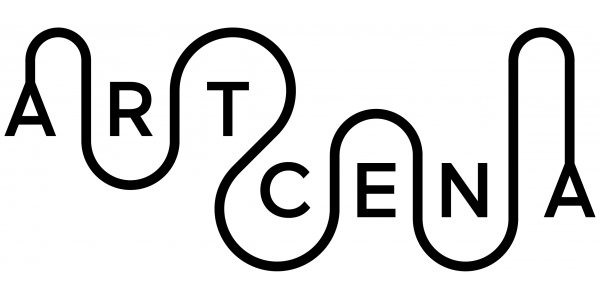

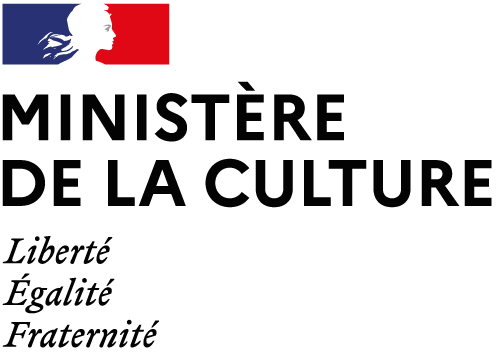
write us: infocircostrada@artcena.fr